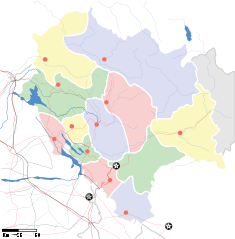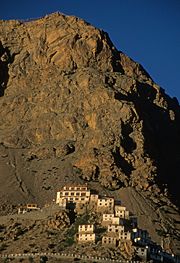Lahaul and Spiti
| ?Lahaul-Spiti Himachal Pradesh • India |
|


|
|
| Coordinates: | |
| Time zone | IST (UTC+5:30) |
| Area | 13,833 km² (5,341 sq mi) |
| Headquarters | Keylong |
| Population • Density • Literacy rate |
33,224 • 2 /km² (5 /sq mi) • 73.10% |
| Deputy Commissioner | |
| Codes • Telephone |
• ++ 91 (0) |
The district of Lahaul-Spiti in the Indian state of Himachal Pradesh consists of the two formerly separate districts of Lahaul and Spiti. The present capital is Keylong in Lahaul. Before the two districts were merged, Kardang was the capital of Lahaul, and Dhankar the capital of Spiti.
Kunzum la (altitude 4551 m) is entrance pass to Spiti Valley from Lahaul Valley. It is at a distance of 9km from Chandra Tal.[1] This district is connected to Manali through Rohtang pass.
Contents |
Flora and fauna

The harsh conditions of Lahaul permit only scattered tufts of hardy grasses and shrubs to grow, even below 4,000 metres. Glacier lines are usually found at 5,000 metres.
Animals such as yaks and dzos roam across the wild Lingti plains. However, over-hunting and a decrease in food supplies has led to a large decrease in the population of the Tibetan antelope, argali, kiangs, musk deer, and snow leopards in these regions, reducing them to the status of endangered species. However, in the Lahaul valley, one can see ibex, brown bears, foxes and snow leopards during winter.
People
The language, culture, and populations of Lahaul and Spiti are closely related. Generally the Lahaulis are of Tibetan and Indo-Aryan descent, while the Spiti Bhotia are more similar to the Tibetans, owing to their proximity to Tibet. Fairer skin and hazel-colored eyes are commonly seen among the Lahaulis.
The languages of both the Lahauli and Spiti Bhotia belong to the Tibeto-Burman family. They are very similar to the Ladakhi and Tibetans culturally, as they had been placed under the rule of the Guge and Ladakh kingdoms at occasional intervals.
Among the Lahaulis, the family acts as the basic unit of kinship. The extended family system is common, evolved from the polyandric system of the past. The family is headed by a senior male member, known as the Yunda, while his wife, known as the Yundamo, attains authority by being the oldest member in the generation. The clan system, also known as Rhus, plays another major role in the Lahauli society.
The Spiti Bhotia community has an inheritance system that is otherwise unique to the Tibetans. Upon the death of both parents, only the eldest son will inherit the family property, while the eldest daughter inherits the mother's jewellery, and the younger siblings inherit nothing. Men usually fall back on the social security system of the Trans-Himalayan Gompas.
Lifestyle
The lifestyles of the Lahauli and Spiti Bhotia are similar, owing to their proximity. Polyandry was widely practiced by the Lahaulis in the past, although this practice has been dying out. The Spiti Bhotia do not generally practice polyandry any more, although it is accepted in a few isolated regions.
Divorces are accomplished by a simple ceremony performed in the presence of village elders. Divorce can be sought by either partner. The husband has to pay compensation to his ex-wife if she does not remarry. However, this is uncommon among the Lahaulis.
Agriculture is the main source of livelihood. Occupations include animal husbandry, working in government programs, government services, and other businesses and crafts that include weaving. Houses are constructed in the Tibetan architectural style, as the land in Lahul and Spiti is mountainous and quite prone to earthquakes.
Religion


Most of the Lahaulis follow a combination of Hinduism and Tibetan Buddhism of the Drukpa Kagyu order, while the Spiti Bhotia follow Tibetan Buddhism of the Gelugpa order. Within Lahul, the Baralacha-La region had the strongest Buddhist influence, owing to its close proximity to Spiti. Lahul has temples such as Triloknath, where pilgrims worship a certain god in different manifestations, notably in the form of Shiva and Avalokiteshvara. This bas-relief, of marble, depicts the Buddhist deity Avalokiteshvara (the embodiment of the Buddha's compassion) in a stylized seated position; Hindu devotees take it to be Shiva Nataraj, Shiva dancing. This image appears to be of sixteenth century Chamba craftsmanship. It was created to replace the original black stone image of the deity, which became damaged. This original image is kept beneath the plinth of the shrine. It appears to be of 12th century Kashmiri provenance.
Before the spread of Tibetan Buddhism and Hinduism, the people were adherents of the religion 'Lung Pe Chhoi', an animistic religion that had some affinities with the Bön religion of Tibet. While the religion flourished, animal and human sacrifices were regularly offered up to the 'Iha', a term that refers to evil spirits residing in the natural world, notably in the old pencil-cedar trees, rocks and caves. Vestiges of the Lung Pe Chhoi religion can be seen in the behaviour of the Lamas, who are believed to possess certain supernatural powers.
The Losar festival (also known as Halda in Lahauli) is celebrated between the months of January and February. The date of celebration is decided by the Lamas. It has the same significance as the Diwali festival of Hinduism, but is celebrated in a Tibetan fashion.
At the start of the festival, two or three persons from every household will come holding burning incense. The burning sticks are then piled into a bonfire. The people will then pray to Shiskar Apa, the goddess of wealth (other name Vasudhara) in the Buddhist religion.
Tourism

The natural scenery and Buddhist monasteries, such as Ki, Dhankar, Shashur, Guru Ghantal and Tayul Gompas, are the main tourist attractions of the region.
One of the most interesting places is the Tabo monastery, located 45km from Kaza, the capital of the Spiti region. Tibet. This monastery rose to prominence when it celebrated its thousandth year of existence in 1996. It houses a collection of Buddhist scriptures, Buddhist statues and Thangkas. The ancient gompa is finished with mud plaster, and contains several scriptures and documents. Lama Dzangpo heads the gompa here. There is a modern guest house with a dining hall and all facilities are available.
Another famous monastery, Kardang Gompa, is located at an elevation of 3,500m across the river which is about 8 KM from Keylong. Kardang is well connected by the road via the Tandi bridge which is about 14 km from Keylong. Built in the 12th century, this monastery houses a large library of Buddhist, Kangyur and Tangyur scriptures.
The treacherous weather in Lahaul and Spiti permits visitors to tour only between the months of June to October, when the roads and villages are largely free of snow. Even though it is possible to access the region from Kinnaur (along the Saltuj) all through the year, the road is permanently closed at Mulling.
Avalanches and poorly tarred roads are another issue, cases of tourists getting killed or injured while making their way to villages have already occurred.
See also
|
|||||||||||||||||
References
- Kapadia, Harish. 1999. SPITI: Adventures in the Trans-Himalaya. 2nd edition. Indus Publishing Co., New Delhi. ISBN 81-7387-093-4
External links
| Lakes | Renuka Lake | Maharana Pratap Sagar | Gobind Sagar (more...) |
|---|---|
| Rivers | Beas | Chenab | Ravi | Sutlej | Yamuna |
| Districts | Bilaspur | Chamba | Hamirpur | Kangra | Kinnaur | Kullu | Lahaul and Spiti | Mandi | Sirmaur | Shimla | Solan | Una |
| Other | Climate of Himachal Pradesh | Protected areas of Himachal Pradesh | List of peaks in Himachal Pradesh |
|
||||||||||||||